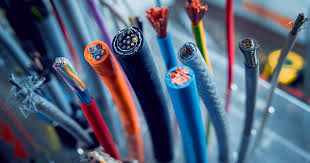
Power Cables are everywhere, from powering the devices we use daily to supporting large-scale industrial operations. While they might seem like simple components, power cables play a vital role in ensuring electricity flows efficiently and safely. This comprehensive guide will delve into everything you need to know about power cables: what they are, their types, uses, and how to choose the right one for your needs.
What is a Power Cable?
A power cable is an electrical cable used to transmit electrical power from one point to another. These cables are made up of several components, including:
- Conductors: Typically made of copper or aluminum, they carry the electrical current.
- Insulation: Surrounds the conductor to prevent electrical leakage and ensure safety.
- Protective Sheath: Protects the cable from physical damage, moisture, and environmental hazards.
Power cables are essential for homes, offices, industrial sites, and even outdoor applications like construction and renewable energy projects.
Types of Power Cables
There’s no one-size-fits-all solution when it comes to power cables. Different applications require different types of cables. Let’s explore the most common ones:
1. Low Voltage Power Cables
- Voltage Range: Up to 1,000 volts.
- Uses: Primarily used in residential and small commercial settings for appliances, lighting, and general power supply.
- Examples: Standard home wiring cables like THHN wires or Romex cables.
2. Medium Voltage Power Cables
- Voltage Range: Between 1,000 and 35,000 volts.
- Uses: Ideal for industrial applications, large commercial buildings, and underground power distribution.
- Examples: Armored cables used in factories.
3. High Voltage Power Cables
- Voltage Range: Above 35,000 volts.
- Uses: Used for long-distance power transmission, such as in electrical grids.
4. Flexible Power Cables
- Characteristics: Highly flexible for dynamic applications.
- Uses: Common in machinery, robotics, and devices requiring frequent movement.
5. Outdoor Power Cables
- Features: Designed to withstand weather, UV rays, and water.
- Uses: Used in construction, outdoor lighting, and renewable energy systems.
6. Armored Power Cables
- Characteristics: Include an additional protective metal layer.
- Uses: Used in hazardous environments like underground wiring or chemical plants.
How Do Power Cables Work?
Power cables work by conducting electricity from one point to another through their metallic core. The insulation layer prevents current leakage and protects users from electric shocks. Depending on the type of cable, additional shielding may help reduce electromagnetic interference or provide mechanical strength.
Key Factors to Consider When Choosing a Power Cable
Choosing the right power cable is critical for ensuring safety, performance, and durability. Here are the key factors to consider:
1. Voltage and Current Requirements
- Ensure the cable can handle the voltage and current needed for your application. Using the wrong cable may result in overheating or failure.
2. Length of the Cable
- Longer cables can experience voltage drops. For extended runs, opt for thicker conductors to minimize energy loss.
3. Environment
- Indoor or outdoor? Wet or dry? Harsh environments may require armored or weatherproof cables.
4. Flexibility
- For moving equipment or applications where cables may bend frequently, choose flexible power cables.
5. Safety Standards
- Ensure the cable complies with safety regulations like UL (Underwriters Laboratories) or IEC (International Electrotechnical Commission) standards.
6. Cost vs. Quality
- Cheaper cables may seem appealing, but they often compromise on safety or durability. Investing in a high-quality cable is always the better choice.
Applications of Power Cables
Power cables are used in virtually every industry. Let’s look at some key applications:
1. Residential Use
- Used for home wiring, connecting appliances, and powering devices.
- Popular Types: Romex and THHN wires.
2. Commercial Use
- Found in offices, retail stores, and commercial buildings to power lighting, HVAC systems, and machinery.
3. Industrial Use
- Heavy-duty power cables are used in manufacturing plants, oil refineries, and construction sites.
- Examples: Medium voltage and armored cables.
4. Renewable Energy
- Solar panels and wind turbines require specialized outdoor power cables to connect to energy storage systems or the grid.
5. Telecommunications and Data Centers
- Power cables are used to ensure uninterrupted power supply for critical IT infrastructure.
Common Materials Used in Power Cables
Power cables are constructed using specific materials to balance conductivity, durability, and cost.
1. Copper
- Pros: High conductivity, flexibility, and durability.
- Cons: More expensive than aluminum.
2. Aluminum
- Pros: Lightweight and cost-effective.
- Cons: Less conductive than copper and requires a larger diameter for equivalent performance.
3. PVC (Polyvinyl Chloride)
- Uses: Insulation and jacketing.
- Features: Affordable, weather-resistant, and flame-retardant.
4. XLPE (Cross-linked Polyethylene)
- Uses: Insulation for high-voltage cables.
- Features: Heat-resistant and durable.
Installation Tips for Power Cables
Proper installation ensures the safety and longevity of power cables. Follow these tips for best results:
- Plan the Layout: Ensure cables are not overloaded or stretched.
- Use Conduits: Protect cables from physical damage, especially in walls or underground.
- Check Connections: Secure connections to prevent arcing or overheating.
- Follow Regulations: Adhere to local electrical codes and standards.
- Test After Installation: Conduct tests to verify proper functionality and safety.
Maintaining and Inspecting Power Cables
Regular maintenance and inspection can extend the life of power cables and prevent accidents.
- Inspect for Damage: Look for cracks, cuts, or wear on the insulation.
- Monitor Performance: Check for overheating or signs of electrical failure.
- Clean Regularly: Keep cables free from dirt and debris, especially in outdoor settings.
- Replace When Necessary: Don’t hesitate to replace damaged or outdated cables.
Emerging Trends in Power Cables
As technology evolves, so do power cables. Here are some exciting trends:
1. Eco-Friendly Cables
- Manufacturers are producing cables with recyclable and non-toxic materials to reduce environmental impact.
2. Smart Cables
- Advanced cables can monitor performance, detect faults, and even alert users to potential issues.
3. High-Temperature Cables
- Designed to withstand extreme conditions, these cables are ideal for renewable energy applications like solar farms.
Where to Buy Power Cables
When purchasing power cables, look for reliable suppliers that offer quality products and comply with safety standards. Some trusted sources include:
- Home Depot: Ideal for residential and DIY needs.
- Grainger: A great option for industrial-grade cables.
- Anixter: Specializes in a wide range of electrical solutions.
Conclusion
Power cables are an essential part of modern life, enabling the flow of electricity for countless applications. Whether you’re wiring a new home, setting up an industrial facility, or working on a renewable energy project, choosing the right power cable is crucial for safety and efficiency.
Understanding the types, materials, and proper usage of power cables empowers you to make informed decisions, ensuring long-lasting performance. Always prioritize quality and adhere to safety standards when selecting and installing power cables.For more detail please visit techwebinsights.com







